Mind Maps for Business Management
Businesses large and small have discovered the power of mind mapping to brainstorm, ideate, and innovate. Mind maps in business can help you and your team unleash hidden ideas and unlock deeper potential. And, no matter where you are in the business process, from gathering ideas to start a new venture or looking to streamline existing processes, mind mapping can help you get to where you want to be.
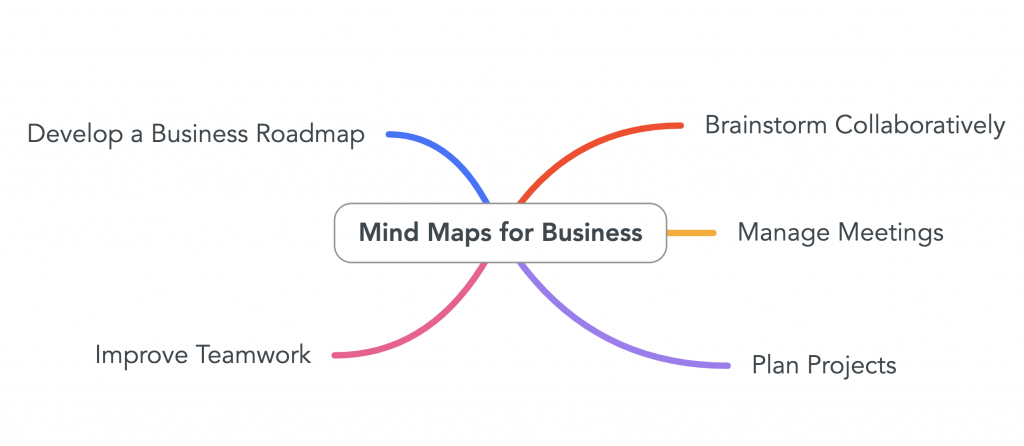
How to mind map for business
Mind mapping is the perfect tool to take your business to the next level. Not only is it quick, easy, and effective, it can save you time and money.
A mind map is a visual and branching diagram that allows you to capture and organize ideas and information. Some key uses for mind maps in business are note taking and brainstorming, but the benefits of mind mapping are many. In business, mind mapping can
- boost productivity,
- develop deeper critical thinking skills,
- improve creativity with visual thinking,
- enhance memory retention, and
- foster deeper collaboration within a team.
With all the benefits of mind mapping for your business, let’s take a deeper look at a few ways mind mapping can improve your operation.
Developing a business roadmap
With any business, it’s important for you to have a clear vision. Having a shared goal is equally important to your team as it is this vision that guides everyone through good times and difficult hurdles. It’s what keeps you and your team inspired.
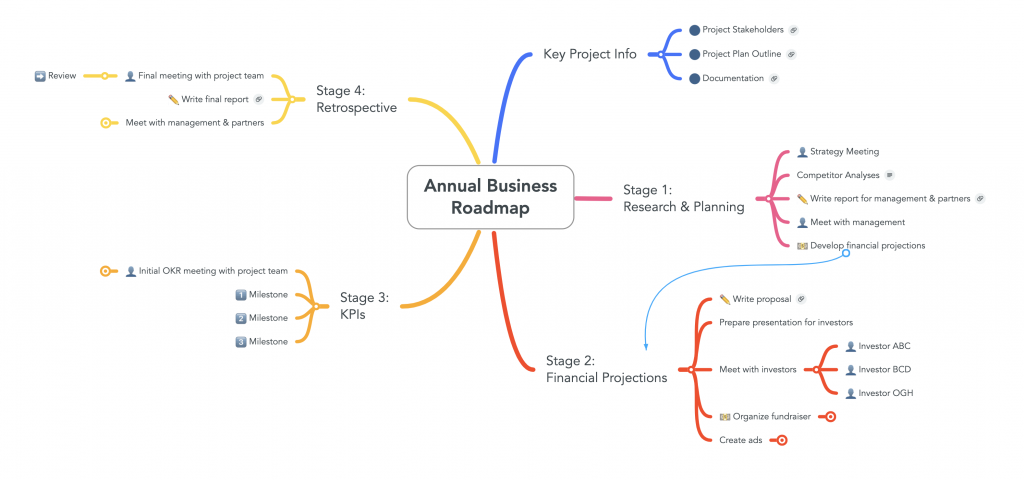
A business roadmap shouldn’t be a quote you hang over the door to set and forget. In fact, developing an annual business roadmap can help you stay on track and adjust or pivot if necessary. It’s remarkably easy to do using a mind map as the visual medium allows you to never lose sight of the central mission of your organization while planning short, medium, and long-term goals. With mind maps, you can cover a variety of business topics:
- Goals for each quarter
- KPIs you’ll be focusing on (Churn, MRR, CMRR)
- Financial projections
- Competitive analyses
Once you start mind mapping, you will discover how versatile it truly is. Mind mapping will change not only the way you plan for your business, but it will also change how you conduct your daily tasks.
Mind mapping for meeting management
It’s no secret, most businesses conduct far too many meetings. On average, U.S. workers spend two hours a week in pointless meetings. That’s two hours your team could use to further the goals and objectives of the organization. What’s more, these pointless meetings end up costing U.S. companies nearly $400 billion each year.
Mind mapping is a secret weapon to banish hours of wasted time and money with poor meeting management. Why? Because running an effective meeting requires an agenda to stick to the goal of the meeting and comprehensive meeting minutes to keep stakeholders informed on key decisions and action items. When putting together an agenda, make sure to:
- Ask for input from meeting attendees
- Organize the flow of the meeting and note any item where a decision needs to be made
- Identify who will lead the discussion for each agenda item or topic
- Leave room for any last-minute questions or additions
Using an online mind mapping tool like MindMeister can help you create an agenda that is collaborative so that attendees can add items, gather any information needed in advance, or provide further context making sure the meeting itself stays on point.
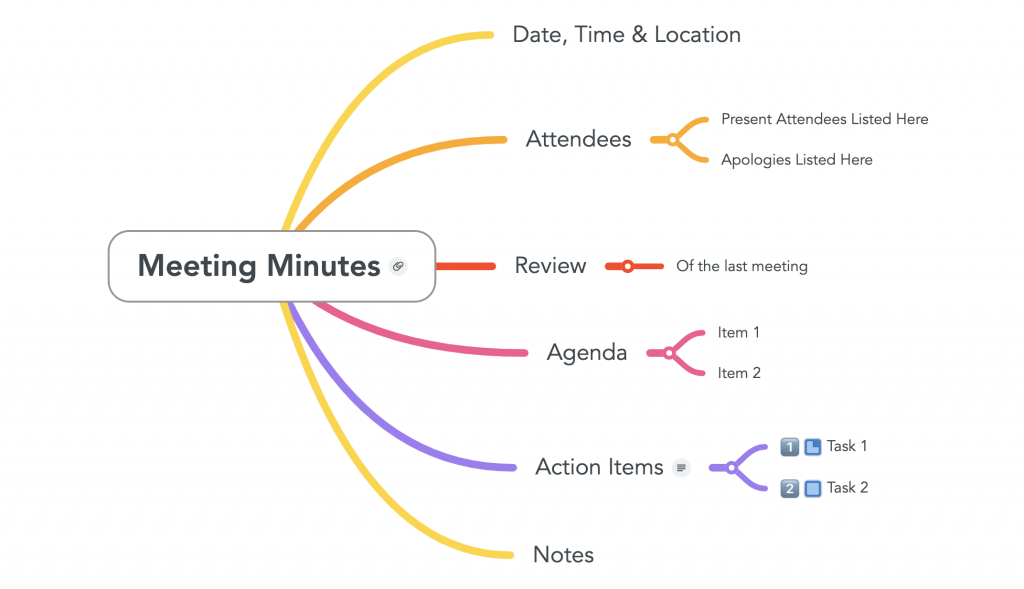
Once the meeting is in progress, easily document meeting minutes with a mind map. Its two-dimensional structure builds out from the center so the note-taker can add topics of discussion, subtopics and action items. Traditional, linear note taking doesn’t leave room for adding additional comments or ideas.
But, by using a mind map, last-minute information can be added given the radial structure of the map. Plus, this visual note-taking process enables your team to quickly spot bottlenecks and holes in planning.
When your meeting requires your team to put their heads together and brainstorm, a mind map is the tool for effective and collaborative brainstorming.
Mind mapping for collaborative brainstorming
Whiteboards are now-ubiquitous office staples. And, by this point in your business career, you are quite familiar with generating ideas, making decisions and coming up with creative solutions to problems, in a word, brainstorming.
Brainstorms usually focus on one particular problem at a time. And, they usually follow four basic principles:
- Quantity over quality: During a session, participants are encouraged to come up with as many ideas as possible.
- Leave criticism at the door: Participants shouldn’t judge ideas, neither their own nor another’s ideas.
- Embrace unusual ideas: Quirky, unusual or wild ideas are not only accepted, but they are also encouraged.
- Combine, refine, improve: Participants should build on each other’s ideas.
The above principles are easy to understand but often harder to follow. In fact, brainstorming in groups may not always be the most effective. You can do a “braindump” of ideas and quickly draw connections between similar ideas on a whiteboard, but studies have found that traditional in-person brainstorms often see poorer results than the same number of people working independently.
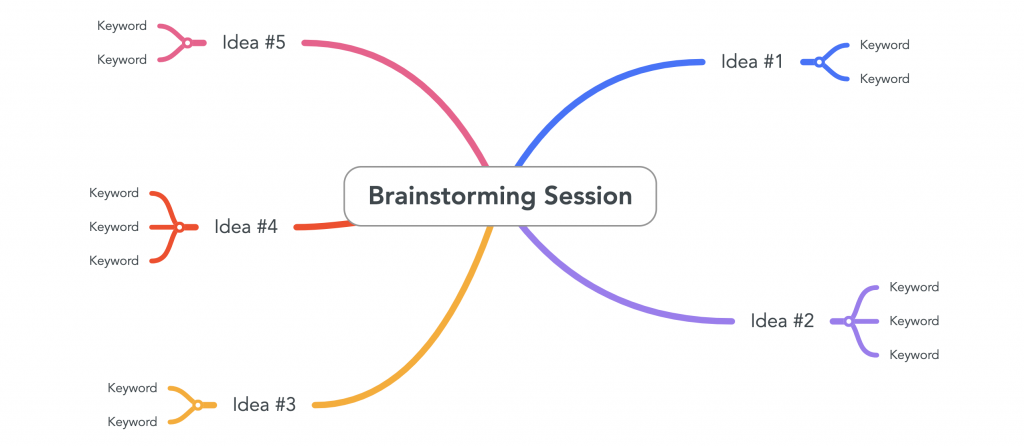
The problems associated with traditional brainstorming can be solved with collaborative and web-based mind mapping software. Tools like MindMeister allow teams to brainstorm together in real time without having to be in the same room. And, by using a web-based tool instead of a whiteboard, your brainstorm is now a living document you can refer to again and again, as well as share with stakeholders or other team members.
Plus, you are able to add colors, icons, and images to further enhance your brainstorming session. When using an online mind map to brainstorm, you level the playing field for your whole team.
Mind mapping for project planning
Each business has its own set of goals, complete with unique problems and opportunities. Whether your business is just getting started or you are a seasoned pro, finding a solid project planning and management system is essential to keeping things humming. Mind maps are a valuable tool for this as they structure information visually which provides an overview of all the project-related data. Mind maps in business make project management a cinch.
The Five Stages of Project Management
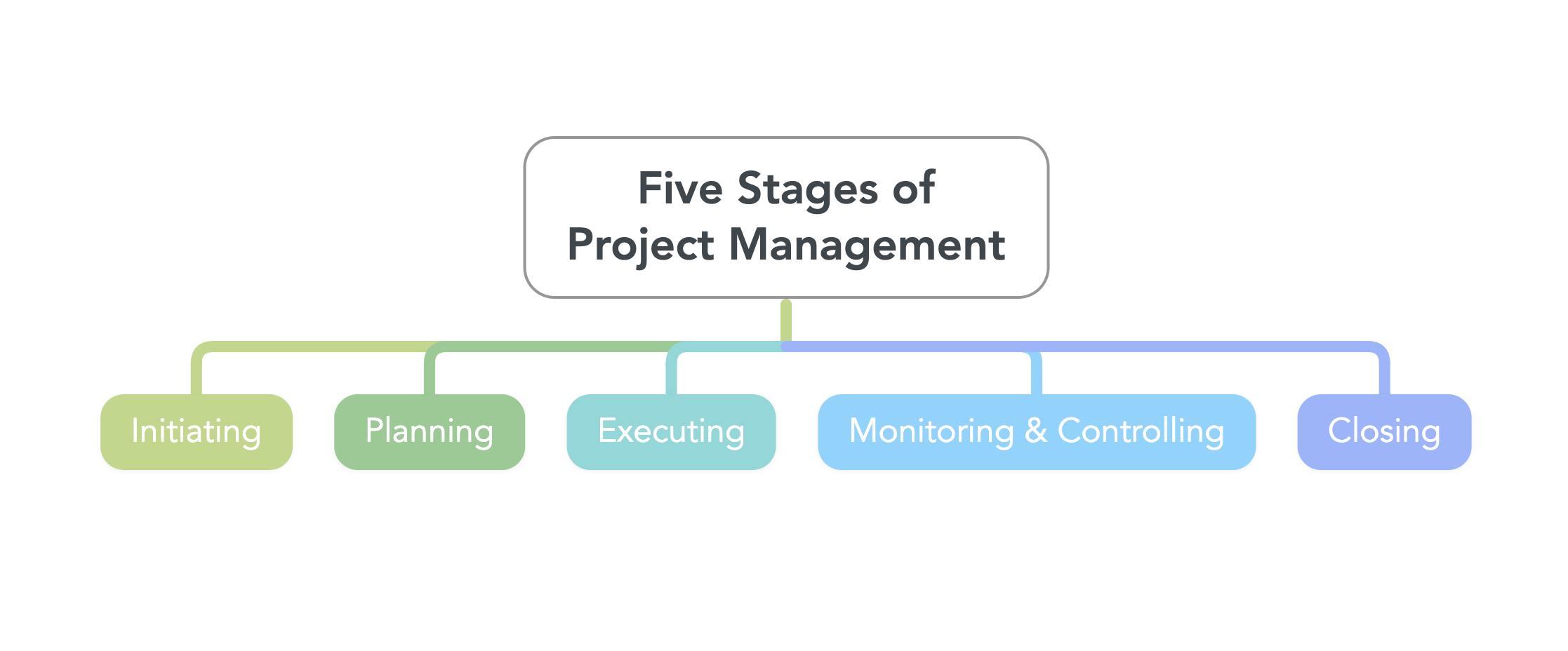
The bigger the project, the more critical management becomes — especially if you want to come in on time and budget. There are five processes (outlined below) of expert project management:
- Initiating
- Planning
- Executing
- Monitoring and Controlling
- Closing
Take a deeper dive to learn more about project management and planning with the five stages of project management.
Creating a Project Plan: Where to begin?
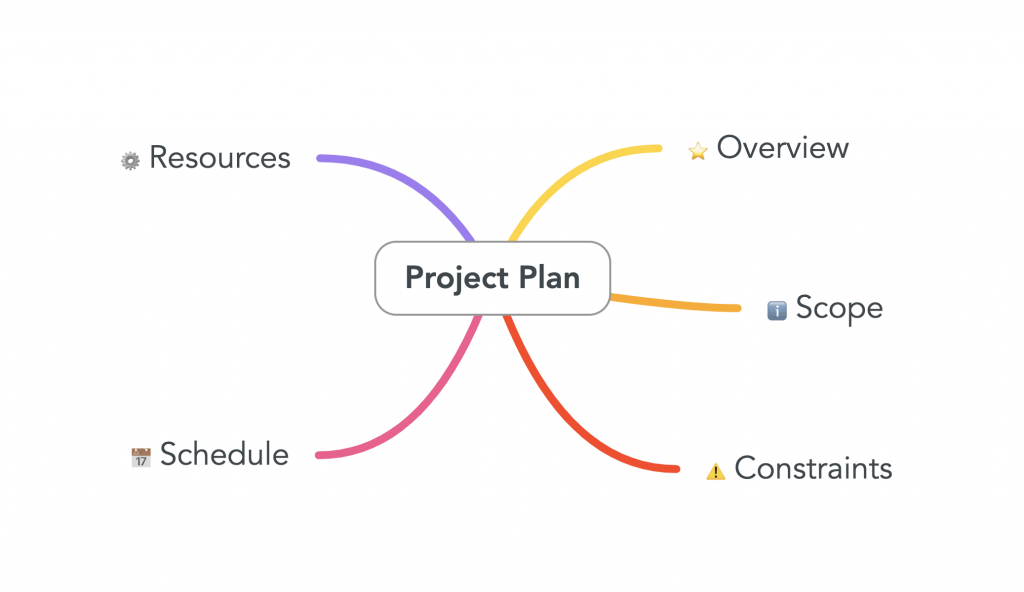
All good projects start out with an idea. After coming up with that initial inspiration and working through it with a brainstorming session either alone or with your team, you’re ready to pull together all the disparate pieces of information and organize.
If you’re using a mind map to document your ideas during your brainstorm, compiling and sorting the information into categories makes the project a lot more manageable. You’re able to create a clearer picture of all the tasks that need to be completed and move on to the next steps. In addition to compiling ideas and organizing, you can use mind maps to:
- Outline your goals and objectives
- Perform a cost-benefit analysis
- Create a project stakeholder list
- Identify project deliverables
Once you’ve got a clear picture of your project, deliverables and desired outcomes, key players, and other relevant information, you are ready to move forward. If you’re using a web-based mind mapping tool, you can create an overview mind map for project management.
This map will hold all key information for each project, including links to relevant articles, documents, images and videos. Not only will you be able to document all of the pieces, because of the radial structure of a mind map you are able to see it all at a glance.
When working in a team, share the project mind map for transparency and agile project management. You can use colors and icons to indicate where a task is in the process, from open, to in progress, blocked, or completed, making sure every team member has a clear view of where the project is and what needs to be done.
Mind Mapping to Improve Customer Experience
We live in the age of the customer. This era of the customer represents the next business imperatives, with customer experience as the differentiator and an opportunity for companies and organizations to embrace the customers and anchor their strategy around customers to fuel their growth.
Customer experience, often called CX, is defined as, “The perception that customers have of an organization – one that is formed based on interactions across all touchpoints, people, and technology over time.” (Customer Experience Professionals Association, CXPA)
To improve the experience of your customers, you first need to understand the journeys your customers take. Journey maps help companies figure out which touchpoints are value-creating and which are value-eroding. Across industries, overall journey experience is a far better predictor of customer satisfaction and business outcomes than satisfaction around a single touchpoint. By better understanding the steps and stages involved in customers’ journeys, and managing entire customer journeys, companies can improve the customer experience and create a competitive advantage over competitors.
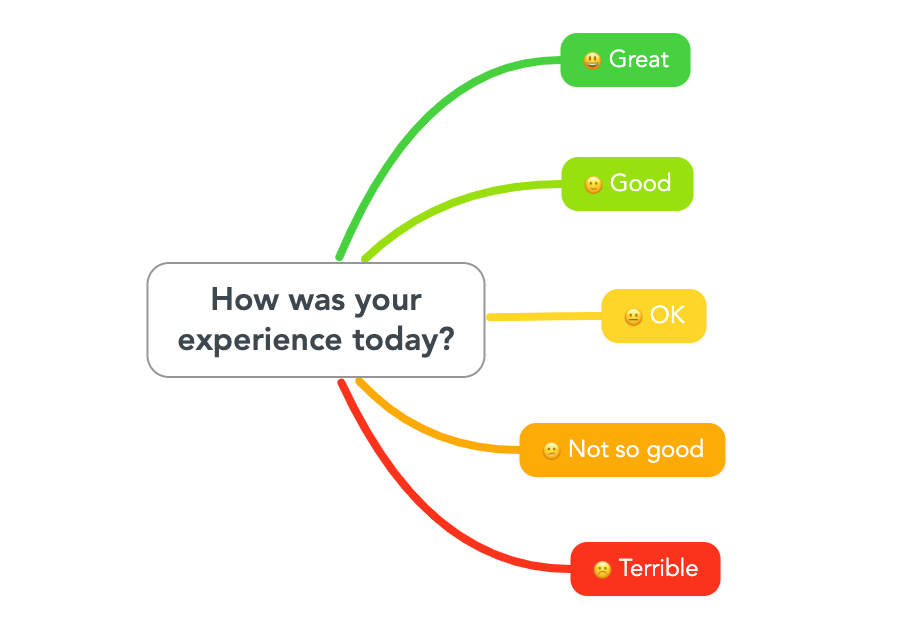
How to Journey Map with Mind Maps?
Journey maps are useful because they visually illustrate the experience a customer has with a service, product, or company over the customer journey. The best way to create a journey map is with a visual, flexible, and collaborative journey mapping software.
Journey mapping steps with mind maps:
- Begin with the title of the journey map as the central topic. Add purpose, scope, persona, and data collection information in the notes.
- Create journey stages as subtopics to the central topic.
- Add touchpoints as subtopics to journey stages. Give them a descriptive title. In the notes, describe each touchpoint. Add a channel of communication as an icon. Add a storyboard image.
- To each touchpoint, add three subtopics: experience, insight, and action. For each experience subtopic, describe the experience in the notes and add an emotion icon.
- Format for additional visual impact.
Learn more about Journey Mapping for Customer Success
Other Mind Map Examples and Best Practices
The above examples are just a few ways mind mapping can help you improve your business. Once you start using mind maps for business, you’ll soon find that the options are endless. Whether you want to improve productivity, infuse creativity, or build more value, here are a few more ideas:
Effort-Impact Matrix
The effort-impact matrix helps you decide which task and projects to focus on. This mind map template helps you identify quick wins, estimated effort, and probable impact for projects you undertake.
Marketing Persona
Developing a marketing persona allows you to create key messaging for a target consumer. To start, create a personality that helps you to visualize who you are marketing to and how the person will use your product or service.
Pros and Cons
Creating pros and cons lists have never been easier. If you’re using a web-based mind map, you can constantly update or amend your list as new information becomes available. Never make a poorly-informed decision again.
Company Org Chart
Keep your entire company on the same page with a company org chart mind map. Be sure to include name, title, and contact information. Additionally, this mind map is particularly helpful when onboarding new employees.
Meeting Minutes
With a mind map agenda, you will never have a meeting run long again. Start by setting a meeting agenda. Then, you are able to control how the meeting proceeds. With a visual agenda, it’s easier to stay on track and not lose focus.
